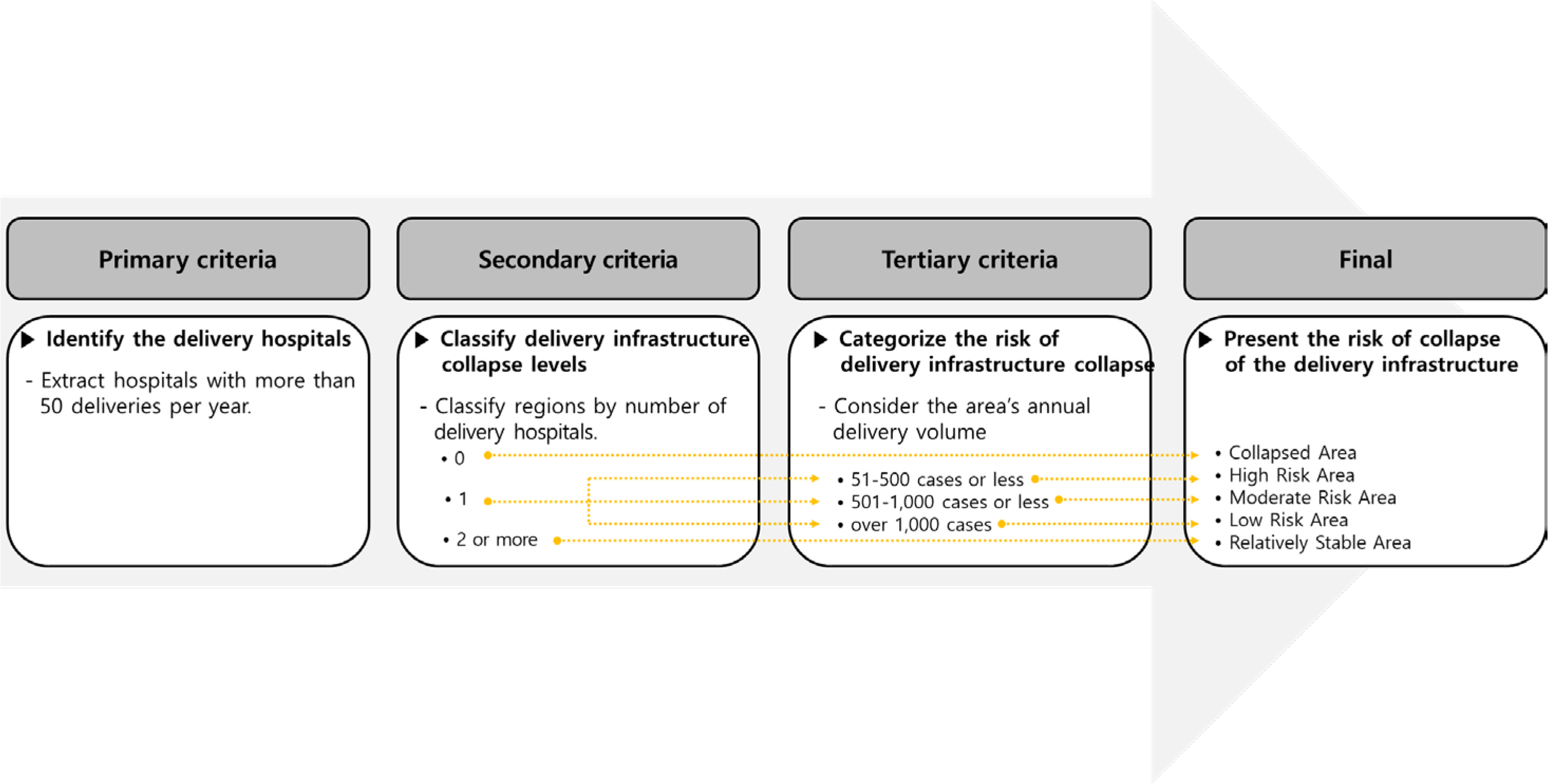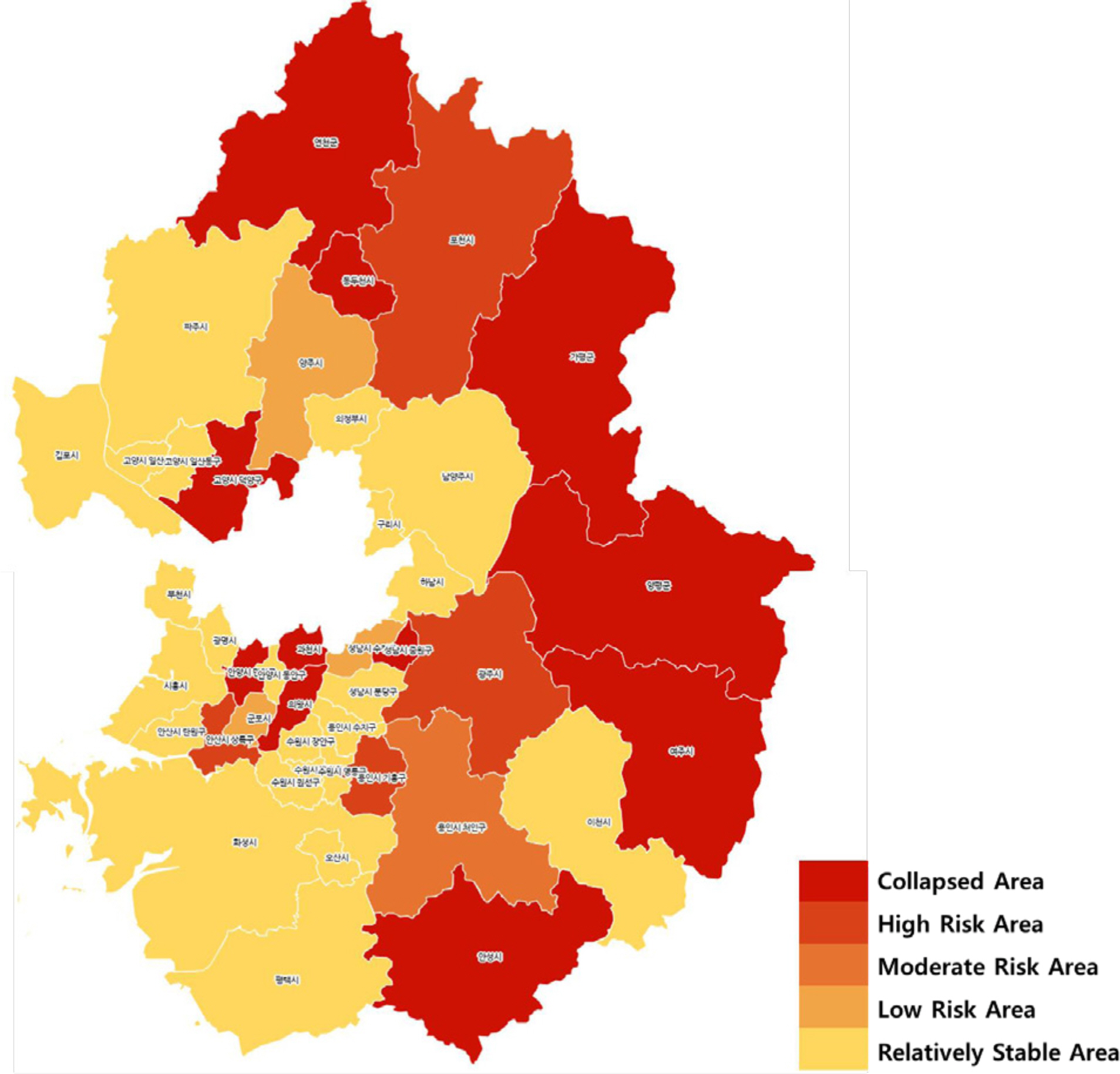J Korean Matern Child Health
.
2024 Oct;28(4):156-166. 10.21896/jkmch.2024.28.4.156.
Development and Application of a Delivery Infrastructure Collapse Risk Assessment Tool: A Focus on Metropolitan Metropolitan Areas
- Affiliations
-
- 1Gyeonggi Public Health Policy Institute, Seongnam, Korea
- 2Department of Obstetrics and Gynecology, Kangwon National University College of Medicine, Chuncheon, Korea
- 3Unit for Public Health Care, Seoul National University Bundang Hospital, Seongnam, Korea
- KMID: 2560351
- DOI: http://doi.org/10.21896/jkmch.2024.28.4.156
Abstract
- Purpose
This study aims to develop a tool to systematically assess the risk of collapse in the delivery infrastructure and apply it to 42 districts in Gyeonggi Province. The ultimate goal is to provide data for preventive and improvement strategies tailored to regional needs.
Methods
Hospitals performing over 50 deliveries annually were identified. Regions were categorized as 'none,' 'one,' or 'more than two' delivery hospitals, with further subdivision by annual delivery volume. Regions were then classified into 5 categories: 'relatively stable,' 'low-risk,' 'moderate-risk,' 'high-risk,' and 'collapsed.'
Results
Of the 42 districts, 23 were classified as relatively stable, 3 as low-risk, 1 as moderate-risk, 4 as highrisk, and 11 as collapsed. Notably, areas where the delivery infrastructure has collapsed or is at high risk of collapse accounted for approximately 36% of the total.
Conclusion
Tailored strategies and urgent policy support are required for high-risk regions. While perinatal regionalization may be a future direction, stable infrastructure must be maintained until the maternal care delivery system is established.
Keyword
Figure
Reference
-
Ahn TK., Hwang JY. Can an increase in delivery medical fees prevent the collapse of the Maternity Infrastructure System? J Korean Soc Matern Child Health. 2023. 27:51–9.
ArticleBlondel B., Drewniak N., Pilkington H., Zeitlin J. Out-of-hospital births and the supply of maternity units in France. Health Place. 2011. 17:1170–3.
ArticleCarrel M., Keino BC., Ryckman KK., Radke S. Labor & delivery unit closures most impact travel times to birth locations for micropolitan residents in Iowa. J Rural Health. 2023. 39:113–20.
ArticleFontenot J., Brigance C., Lucas R., Stoneburner A. Navigating geogra- phical disparities: access to obstetric hospitals in maternity care deserts and across the United States. BMC Pregnancy Childbirth. 2024. 24:350.Friedman AM., Ananth CV., Huang Y., D’Alton ME., Wright JD. Hospital delivery volume, severe obstetrical morbidity, and failure to rescue. Am J Obstet Gynecol. 2016. 215:795.e1–795.e14.Handley SC., Lorch SA. Regionalization of neonatal care: benefits, barriers, and beyond. J Perinatol. 2022. 42:835–8.
ArticleHandley SC., Passarella M., Herrick HM., Interrante JD., Lorch SA., Kozhimannil KB, et al. Birth volume and geographic distribution of US hospitals with obstetric services from 2010 to 2018. JAMA Netw Open. 2021. 4:e2125373.
ArticleHoffmann J., Dresbach T., Hagenbeck C., Scholten N. Factors associated with the closure of obstetric units in German hospitals and its effects on accessibility. BMC Health Serv Res. 2023. 23:342.
ArticleHung P., Henning-Smith CE., Casey MM., Kozhimannil KB. Access to obstetric services in rural counties still declining, with 9 percent losing services, 2004-14. Health Aff (Millwood). 2017. 36:1663–71.Hung P., Kozhimannil KB., Casey MM., Moscovice IS. Why are obstetric units in rural hospitals closing their doors? Health Serv Res. 2016. 51:1546–60.
ArticleHwang JY. Limitation and improvement plan of Maternity Healthcare Delivery System in Korea. J Korean Soc Matern Child Health. 2021. 25:250–9.
ArticleKim A. The reality of the collapse of obstetrics and gynecology delivery infrastructure. Health Policy Forum. 2013. 11:78–83. Available from: https://rihp.re.kr/bbs/board.php?bo_table=publication_forum&wr_id=44&sst=wr_hit&sod=asc&sop=and&page=3.Kim JK. Plan for establishing a safe perinatal transport system. J Korean Soc Matern Child Health. 2022. 26:10–9.
ArticleKim TE., Lee SP., Park JM., Whang BC., Kim SY. The effects of ma- ternal age on outcome of pregnancy in healthy elderly primipara. Korean J Perinatol. 2009. 20:146–52.Koike S., Matsumoto M., Ide H., Kashima S., Atarashi H., Yasunaga H. The effect of concentrating obstetrics services in fewer hospitals on patient access: a simulation. Int J Health Geogr. 2016. 15:4.
ArticleKwak MY., Lee SM., Lee TH., Eun SJ., Lee JY., Kim Y. Accessibility of prenatal care can affect inequitable health outcomes of pregnant women living in obstetric care underserved areas: a nationwide population-based study. J Korean Med Sci. 2018. 34:e8.
ArticleLasswell SM., Barfield WD., Rochat RW., Blackmon L. Perinatal regio- nalization for very low-birth-weight and very preterm infants: a meta-analysis. JAMA. 2010. 304:992–1000.
ArticleLee SJ., Kim YJ., Shin HS., Lee TH., Lee BR., Hong HJ, et al. Current status of the delivery rate within the jurisdiction of local govern- ment in Korea. J Korean Soc Matern Child Health. 2022. 26:112–9.
ArticleLee SY., Kim KH. A study on the supply of obstetrics and gynecology infrastructure for ensuring reproductive health. Health Soc Welf Rev. 2021. 41:141–56.Lorch SA., Srinivas SK., Ahlberg C., Small DS. The impact of obstetric unit closures on maternal and infant pregnancy outcomes. Health Serv Res. 2013. 48(2 Pt 1):455–75.
ArticleMennicken R., Kolodziej IW., Augurzky B., Kreienberg R. Concentration of gynaecology and obstetrics in Germany: is comprehensive access at stake? Health Policy. 2014. 118:396–406.
ArticleMinion SC., Krans EE., Brooks MM., Mendez DD., Haggerty CL. Asso- ciation of driving distance to maternity hospitals and maternal and perinatal outcomes. Obstet Gynecol. 2022. 140:812–9.Ministry of Health and Welfare. Announcement of the results of the selection of the first year of resident recruitment in the first half of 2024 [Internet]. Sejong (Korea): Ministry of Health and Welfare;2024. [cited 2024 May 30]. Available from: https://www.mohw.go.kr/board.es?mid=a10503010100&bid=0027&act=view&list_no=1479528&tag=&nPage=1.Ministry of the Interior and Safety. 2022 Local government administ- rative region and population status [Internet]. Sejong (Korea): Ministry of the Interior and Safety;2022. [cited 2024 Jun 7]. Available from: https://www.mois.go.kr/frt/bbs/type001/commonSelectBoardArticle.do?bbsId=BBSMSTR_000000000055&ntt Id=92993.Ministry of Health and Welfare. The notice of the supporting program for obstetric care underserved areas. Sejong (Korea): Ministry of Health and Welfare;2023.National Medical Center. Regional essential health statistics [Internet]. Seoul (Korea): National Medical Center;2024. [cited 2024 Jun 7]. Available from: https://www.ppm.or.kr/board/thumbnailList.do?MENUID=A04010000.Neto MT. Perinatal care in Portugal: effects of 15 years of a regio- nalized system. Acta Paediatrica. 2006. 95:1349–52.
ArticleOgawa K., Urayama KY., Tanigaki S., Sago H., Sato S., Saito S, et al. Association between very advanced maternal age and adverse pregnancy outcomes: a cross sectional Japanese study. BMC Pregnancy Childbirth. 2017. 17:349.
ArticleOh SY. The collapse of infrastructure for childbirth: causes and con- sequences. J Korean Med Assoc. 2016. 59:417–23.
ArticlePark SH., Lim DO. Pregnancy outcomes of singleton childbirth in women aged 40 years and older. Korean Public Health Res. 2013. 39:31–8.Snowden JM., Cheng YW., Kontgis CP., Caughey AB. The association between hospital obstetric volume and perinatal outcomes in California. Am J Obstet Gynecol. 2012. 207:478.e1–7.
ArticleStatistics Korea. Population trends survey 2021 birth and death statistics [Internet]. Daejeon (Korea);Statistics Korea: 2022. [cited 2024 May 30]. Available from: https://kostat.go.kr/board.es?mid=a10301020100&bid=204&tag=&act=view&list_no=416897&ref_ bid=203,204,205,206,207htt.Statistics Korea. Population trends survey 2022 birth and death statistics [Internet]. Daejeon (Korea): Statistics Korea;2023. [cited 2024 May 30]. Available from: https://kostat.go.kr/board.es?mid=a10301020300&bid=204&act=view&list_no=423833.Woodward R., Mazure ES., Belden CM., Denslow S., Fromewick J., Dixon S, et al. Association of prenatal stress with distance to delivery for pregnant women in Western North Carolina. Midwifery. 2023. 118:103573.
ArticleZhao L. Why are fewer hospitals in the delivery business? Working Paper No. 2007-04 [Internet]. Bethesda (MD): NORC at the University of Chicago;2007. [cited 2024 May 30]. Available from: https://www.norc.org/PDFs/Publications/DecliningAccesstoHospitalbasedObstetricServicesinRuralCounties.pdf.
- Full Text Links
- Actions
-
Cited
- CITED
-
- Close
- Share
- Similar articles
-
- Can an Increase in Delivery Medical Fees Prevent the Collapse of the Maternity Infrastructure System?
- Scrub typhus with complications of acute myocarditis and cardiac tamponade in metropolitan areas: two case reports
- A Survey of Radiation Therapy Utilization in Korea from 2010 to 2016: Focusing on Use of Intensity-Modulated Radiation Therapy
- A Comparative Study of Youth Health Risk Behaviors by Region: Focused on Metropolitan Areas, Medium Sized and Small City Areas, and Rural Areas
- The collapse of infrastructure for childbirth: causes and consequences




